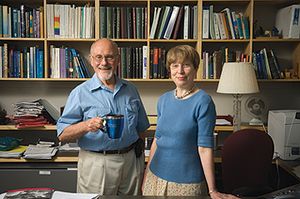Rakai-Projekt
(Dieser Artikel wurde noch nicht aus dem Englischen übersetzt oder enthält noch englische Textpassagen. Bitte beziehe dich vorerst auf die Informationen im englischen Artikel. Klicke dazu in der IntactiWiki-Navigation im Abschnitt "In anderen Sprachen" auf "English".)
The Rakai Health Sciences Program (RHSP) is a program that began in 1987 in Uguanda, Africa to investigate the then-mysterious HIV.[1] The RHSP is headed by husband and wife team Ronald Gray and Maria Wawer (the Senior Principal Investigators),[2] who conduct biased research to look for justifications in rolling out mass circumcision programs around the world.[3] The RHSP is funded by the Johns Hopkins Bloomberg School for Public Health, the Uguanda Virus Research Institute, the National Institutes of Health, and the Bill & Melinda Gates Foundation.[4][5]
Inhaltsverzeichnis
History of the Rakai Project
The Rakai Project was created in 1987 by a group of scientists from Makerere University in Kampala, Uganda who decided to investigate HIV infection in the Rakai district by initiating a small community cohort study. The original senior Principal Investigators of the Rakai Project were Nelson Sewankambo, David Serwadda, and Maria Wawer.[1] The Rakai Project has since changed its name to the Rakai Health Services Program, and has a current staff of just under 400 principal investigators, multidisciplinary professionals, and support staff.[1]
Promoting Circumcision as an HIV Prevention Method
The RHSP promotes mass circumcision as a means to prevent the spread of HIV. A Youtube video uploaded by the Johns Hopkins Bloomberg School for Public Health highlights the RHSP's mass circumcision program.[3]
| ” | Rakai Project Doctor Promotes Circumcision It's been hard to change policy because it's a whole new paradigm. We've never used surgery to prevent an infectious disease. Policy makers had to take some time to really wrap their minds around it. – Ronald Gray (Rakai Project)[6] |
Music Video
At the Rakai clinic, a propaganda music video promoting circumcision plays continuously in the waiting room.[7][8]
| ” | Chorus Lyrics Men should be circumcised |
| ” | Bridge/Outro Lyrics (female singer) Circumcision has got many benefits. You'll become clean, clean, and cleaner... and when the men are circumcised, it reduces sexual infections in women. Circumcision is SO GOOD. Circumcision is SO SAFE. Men should be circumcised! |
Weblinks
- Rakai Health Sciences Program home page at the Johns Hopkins Bloomberg School for Public Health.
- Johns Hopkins University home page at the John Hopkins University website.
Einzelnachweise
- ↑ a b c Rakai Project.
History of the Rakai Health Sciences Program
. Abgerufen 2. Mai 2011. - ↑ Rakai Project.
Our People at Johns Hopkins University
. Abgerufen 2. Mai 2011. - ↑ a b JohnsHopkinsSPH (10. Januar 2012).
Rakai Project
. - ↑ Rakai Project.
Rakai Health Sciences Program
. Abgerufen 2. Mai 2011. - ↑ Kong, Xiangrong (28. Februar 2011)."18th Conference on Retroviruses and Opportunistic Infections, Boston, Massachusetts". Abgerufen 2. Mai 2011.
Zitat:Longer-term Effects of Male Circumcision on HIV Incidence and Risk Behaviors during Post-trial Surveillance in Rakai, Uganda
Acknowledgements slide Video of Presentation with Slides and Audio Download Link - ↑ JohnsHopkinsSPH. (2010). Rakai Project. YouTube.
- ↑ JohnsHopkinsSPH (10. Januar 2012).
Rakai Project
. - ↑ smugamba (10. Oktober 2006).
Rakai male circumcision video by Stephen Mugamba feat Jemima Sanyu.mpg
.

